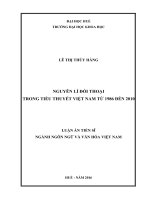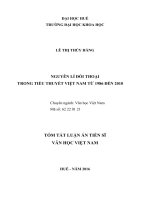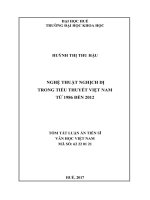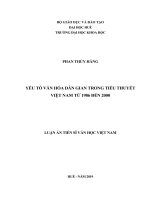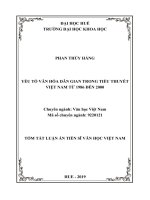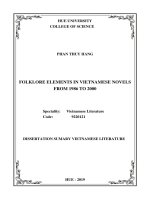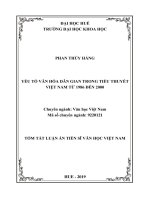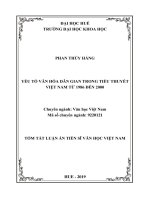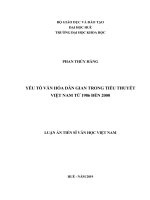Yếu tố văn hóa dân gian trong tiểu thuyết việt nam từ 1986 đến 2000 tt tiếng anh
Bạn đang xem bản rút gọn của tài liệu. Xem và tải ngay bản đầy đủ của tài liệu tại đây (508.09 KB, 26 trang )
HUE UNIVERSITY
COLLEGE OF SCIENCE
PHAN THUY HANG
FOLKLORE ELEMENTS IN VIETNAMESE NOVELS
FROM 1986 TO 2000
Speciality:
Code:
Vietnamese Literature
9220121
DISSERTATION SUMARY VIETNAMESE LITERATURE
HUE - 2019
The dissertation is completed at: ..........................................................
.............................................................................................................
Supervisors:
1. ................................................................................
2. ................................................................................
Reviewer 1: ........................................................................................
........................................................................................
Reviewer 2: ........................................................................................
........................................................................................
Reviewer 3: ........................................................................................
........................................................................................
The dissertation is defented at Hue Univer
sity level Graduate Coucil at ....................................................................
At time…date…month…year…
The dissertation is archived at the library: ...........................................
INTRODUCTION
As two relatively different forms of art in every criterion and mode
of the classification, there is a multi-aspect interaction between folklore
and written literature. The communication is inevitable. Besides, the
penetration of folklore into the written literature is also an unavoidable
phenomenon of literary history. The process of cultural infiltration took
place throughout and continuously in the history of literature, but it was
not until 1986, perceiving folklore in the written literature was pushed up
as a literary trend, a tendency, and a valid method that brought about
many values to the literature. Elements of the folk culture in modern
writers‟ works were the results of a profound rethinking by creating a
persuasive interpretation, giving it new values and meanings. The
process of rebirth and return to folk elements were not merely to repeat
the old, the underdeveloped, nor a backward step, but through the old to
create new values, new pathways of literary creation. Many modern
writers have succeeded and affirmed their fame with such experiments as
Dao Thang, Le Luu, Nguyen Khac Truong, Vo Thi Hao, Ta Duy Anh,
Nguyen Xuan Khanh, and Nguyen Binh Phuong etc. These authors‟
writings were influenced incredibly by folklore. The application of
folklore theory in studying novels from 1986 to 2000 helped us to
explain more fully the artistic works with the system of cultural code that
contained within it.
1
CONTENT
CHAPTER 1
OVERVIEW OF RESEARCH SITUATION
1.1. The situation of studying folklore elements in Vietnamese novels
before 1986
1.1.1. The period from the early twentieth century to 1945
Besides absorbing great influences from Western culture, especially
French culture, the novel of this period was still dominated by Eastern
culture and the national cultural traditions to building a modern
Vietnamese novel but still imbued with the national identity. Studies of
Tu Luc Van Doan‟s novels in terms of culture, society, and customs had
some remarkable works such as Thirty years of literature by Moc Khue,
The history of Vietnamese literature by Duong Quang Ham, The modern
writers by Vu Ngoc Phan, Vietnamese customs in Tu Luc Van Doan’s
novels by Pham Thi Minh Tuyen etc. Studies on regional culture and
Southern characteristics were many researchers‟ interest, for examples,
Vietnamese literature in a new land by Nguyen Q. Thang, Southern
cultural imprints in Ho Bieu Chanh’s novels by Pham Thi Minh Ha etc.
Mentioning to the imprint of folklore in the critical realistic writers‟
novels as Nguyen Cong Hoan, Ngo Tat To, Vu Trong Phung, many
scholars also had some outstanding discoveries of a novelistic trend of
“describing Vietnamese customs” along with conflicts of rich and poor,
good and evil in Vietnamese literature from 1930 to 1945 by Phan Cu De,
The modern writers by Vu Ngoc Phan... Besides, this period had a
section of the literature that existed under the Republic of Vietnam,
which was a part of the Southern urban prose in the period 1954-1975.
Despite the fact that elements of the folk culture were not the object that
writers of the literary section paid attention, however, in the face of the
invasion of foreign culture, some progressive and patriotic authors as Son
Nam, Vu Bang, and Vo Hong had consciously preserved the local culture
by their writings. It should be noted that some typical essays like “New
developments of Southern literature in the temporarily-cccupied area in
2
recent years” (Nguyen Duc Dan), Live and write (Nguyen Ngu I),
Introduction of fifteen years of Southern prose from 1955 to 1969 (Cao
Huy Khanh), Ten faces of art and Ten faces of contemporary art (Ta Ty),
and one of the most recent essays was Prose of Southern urban area in
the period 1954-1975 from perspective of traditional cultural values.
1.1.2. The period from 1945 to 1985
The period from 1945 to 1985 was the literary period associated
with the model of realistic socialist literature prioritizing the movement
of rules of struggle and the victory of the revolution. Under the
revolutionary context, therefore, manifestations of folklore in novels of
the period showed many limitations. As a result, there were not many
prominent studies on the influences of folklore in literary works.
Fortunately, the writers themselves cultivated the national culture when
they travelled to new areas of the country to experience and write. The
literature tended to look for symbols that were able to move and connect
as well as to awaken the cultural consciousness of the community. These
contents could be seen in Doan Gioi and proses of land, and forest of the
South by Huynh Man Chi, Echo of the past by Nguyen Thi Thanh Xuan,
“Some characteristics of highland culture through Nguyen Ngoc‟s
writings of the area” by Hoang Si Nguyen and Le Thanh Toan.
1.2. The situation of studying folklore elements in Vietnamese novels after 1986
1.2.1. General studies on the role of folklore on Vietnamese novels after 1986
There were many noticeable articles discussing on the role of the
folk culture for novels in the period, such as “Culture as a source of
creative and discovering literature” (Nguyen Van Hanh), “Folklore in
Vietnamese contemporary prose” (Vu Thi My Hanh), “Methods of
selecting and depicting the historical reality in Nguyen Xuan Khanh‟s
novels” (Nguyen Van Hung), “History, crulture, and custosms in Nguyen
Xuan Khanh‟s novels” (Vo Hoai Nam) etc.
1.2.2. Specific studies on the presence of folklore elements in Vietnamese
novels after 1986
- Studies on magical elements: It included some remarkable researches
such as Literature of magical elements in Vietnamese contemporary Prose,
3
“The revival of magical elements in Vietnamese contemporary prose” (Bui
Thanh Truyen), “Achievements of the post-renovation Vietnamese prose
from genre-interactive perspective” (Tran Viet Thien), “The role of magical
elements in Vietnamese narratives and novels” (Dang Anh Dao), and “The
Magical World in A land of many people and many ghosts by Nguyen Khac
Truong from the cultural perspective” (Le Nguyen Can) etc.
- Studies on literary symbols: There were some typical articles,
including “The system of artistic symbols in contemporary Vietnamese
novels” by Nguyen Duc Toan, “Village shrines - A unique cultural
symbol of Vietnamese pastoral novels after the renovation” and “pastoral
culture in the post-renovation novels from the perspective of symbols and
languages” by Nguyen Thi Mai Huong, “Some symbols bring maternal
consciousness in Nguyen Xuan Khanh‟s carrying rices to temple” by
Hoang Thi Hue, “The archetypal symbol in Vo Thi Hao‟s prose” by
Nguyen Thi Phuong Ly and Le Thi Huong, “Searching archetypal
symbols in Vietnamese literature” by Nguyen Thi Thanh Xuan.
Particularly, Tran Thi Mai Nhan, the author of the doctoral thesis
Innovations of Vietnamese novels from 1986 to 2000, had some
noticeable results on “Structuralise by symbolic system”.
- Studies on spiritual culture: It can be listed “Spiritual literature
and culture” (Tran Dinh Su), “An approach to Vietnamese novels during
the period of the renovation” (Nguyen Bich Thu), “Spiritual dimensions
in contemporary Vietnamese novels” (Nguyen Van Hung), “Spiritual
issues in Vietnamese novels during the period of the renovation” (Tran
Thi Mai Nhan), and “Spiritual elements in Vietnamese pastoral novels in
the period of the renovation” (Bui Nhu Hai) etc. In this period, Nguyen
Xuan Khanh emerged as a famous writer not only because of his
particular content and styles of expression but also because of the picture
of colourful folklore that he depicted in his novels. Additionally, it
should be noted to some other essays such as “Maternal Principles in
Vietnamese Literary Tradition” (Duong Thi Huyen), “Legendary
elements in Nguyen Xuan Khanh‟s novels” (Nguyen Thi Thu Huong),
4
“The obsession of folk beliefs in The Mother of the forest” (Tran Thi An),
“The Mother of the Forest - The interpretation of Vietnamese People‟s
maternal worship customs” (Nguyen Thi Dieu Linh) etc.
1.3. Evaluate the study status and the pathway to implementing the
research
1.3.1. Evaluate the study situation
Nowadays, folklore is not merely a theoretical system but has become
a research method and an practical approach to cultural decoding in literary
works. Especially, scholars have affirmed the development of culture
related to the destiny of the nation, particularly in the trend of globalisation
and the era of the explosion of digital technology, people are worried about
losing the national cultural identity. Hence, the issue of preserving and
protecting traditional culture are paid more and more attention. From 1986
to 2000, many academic works, books, scientific papers, and essays have
proved the presence of folklore elements in novels in the period,
simultaneously demonstrated that there was a close relationship between
the folk culture and Vietnamese novels from 1986 to 2000. However, these
studies primarily analysed the matter in the scope of ideological content
but less focused on artistic aspects from the perspective of folklore. Some
issues had not been clearly described, as well as systematised into a
phenomenon in almost novelistic authors in this period.
1.3.3. The pathway to implement the research
Firstly, it surveyed the occurrence of folklore elements in the local
novels from 1986 to 2000 in order to have an overview of the messages,
which covered by folklore colours, that authors put into novels.
Secondly, it put elements of folk culture in the history of Vietnamese
novels from the beginning of the twentieth century so far in order to see
the diversified movement and development of novels of the period on the
one hand. It also proved that along with other factors, the folk culture was
an interesting approach and brought about high aesthetic effects when
conducting the study and decoding literary writings on the other hand.
Thirdly, departing from issues of the theory of folklore, the thesis went
deep in exploring the relationship between folklore and modern Vietnamese
5
novels, as well as understanding beliefs, practices and customs, and folk
narrative elements in Vietnamese novels from 1986 to 2000.
Fourthly, the thesis focused on analysing the method of expression
in Vietnamese novels from 1986 to 2000 from the perspective of folklore
through some aspects such as symbolic system, motifs, languages,
characters, artistic space and time. These were factors that contributed to
the success of Vietnamese novels in the last fifteen years of the twentieth
century. In particular, it determined the core mission of the thesis was to
clarify the artistic effect of folklore elements in manifesting content as
well as the artistic method and the impact of folklore elements on
reforming Vietnamese novels after 1986.
CHAPTER 2
FOLKLORE AND THE IMPACT TO VIETNAMESE NOVELS
FROM 1986 TO 2000
2.1. Overview of folklore and the relationship between folklore and
modern Vietnamese novels
2.1.1. Concept of folklore
Folklore researchers of Vietnam, on the basis of foreign researchers‟
studies and evaluation on connotation of the folk culture, had come up
with a unified concept: Folklore is a part of national culture, including
folk literature (folk songs, folk poems, fairy tales...), folk art (folk dances
and music, folk paintings...), folk customs, folk practices, folk rituals etc.
Due to the connotation of the concept of folklore is quite wide, in order
to be appropriate the research scope of the thesis, it would like to find out
manifestations of folklore elements in novels from 1986 to 2000 in some
aspects, such as folk beliefs, the world of characters, artistic space and
time, motifs, symbols, and languages.
2.1.2. Identify folklore elements
According to researchers, elements of folklore include the below factors:
Folk literature and language contain folk narrative, folk lyricism,
folk idioms, proverbs, and folk riddles.
Folk arts contain folk visual arts and folk performing arts.
6
Folk knowledge contains the knowledge of the natural environment,
knowledge of people, knowledge of social behaviour, and knowledge of
production.
Beliefs, customs, and festivals: The above research fields arose,
existed, and developed as a whole body that incarnated the non-separable
nature among parts (literature and languages, arts, knowledge, beliefs,
customs), between creative and enjoyable activities in cultural life,
between cultural-artistic creativeness and working life of the people.
2.1.3. The relationship between folklore and modern Vietnamese novels
It should be affirmed that there was an intimate connection between
folklore and literature. In the early years of the twentieth century, the
reception of cultural factors still occurred in the writing of many writers
including Ho Bieu Chanh, Ngo Tat To, Nguyen Cong Hoan, and other
authors who belonged to the literary school Tu Luc Van Doan. In the
period 1945 to 1975, the folk culture in literature did not appear as much
as in the previous literature. Fortunately, it did not completely lose the
flow but was still present in some works, for examples, The land and
forest of The South by Doan Gioi, The country stands up, The Xanu
forest, Ninh Nong month, Memories of highland by Nguyen Ngoc, and
The West by To Hoai. In 1975, Vietnam was fully liberated, her history
entered a new era of independence and freedom. In order to be
conformable with the new context, the need to innovate every aspect of
social life was more urgent than ever. In addition to reflecting
contemporary matters, literature at that time had also described the
national cultural values in their writings. Some typical authors of this
writing trend included Nguyen Khac Tuong, Nguyen Xuan Khanh,
Nguyen Ngoc Tu, Ta Duy Anh, Vo Thi Hao, and Nguyen Binh Phuong.
Folklore elements in the literary period from 1975 so far, particularly
after 1986, reappeared in literature stronger than ever. These factors in
the post-1986-literature had been associated with the manifestation of
beliefs, practices, customs, festivals that imbued with the national
7
identity such as the maternal worship belief, the polytheism belief,
totemism, proliferative belief, ancestors and deceased people worship,
natural worship, as well as folk knowledge of personal behaviour and
community behaviour, folk knowledge of natural environment and
human beings, and folk performing arts. Regarding the way of depiction,
folklore elements were clearly present in the discovery of magical factors,
mythicism, applying many legends, folk songs, proverbs that created the
charm and beauty for literary works. Furthermore, the construction of
motif system, which filled by folklore colours such as the motif of
dreams, the motif of death, ghost, souls, and the motif of retribution. In
many writings, lots of symbols coordinated with the community culture
from a long time ago, including water, fire, stone, village shrines, banyan
trees, stone dogs, holy snakes... These symbols portrayed an artistic
world that was full of folklore characters in writers‟ novels in the period,
for instances, Nguyen Khac Truong, Le Luu, Bao Ninh, Dao Thang, Vo
Thi Hao, Nguyen Xuan Khanh, and Nguyen Binh Phuong.
2.2. The impact of folklore on Vietnamese novels from 1986 to 2000
2.2.1. Folklore and the change of artistic thought
As the “original culture”, “maternal culture”, the folk culture
contributed to forming the foundation, establishing the original methods
and means of reality perception by images, simultaneously, playing an
essential role in creating a sense of the national community. Its faces
demonstrated as tending to close and favouring the strange and unusual
things, manifesting the divine worldview and mythical thought in writers‟
viewpoint of all time. Especially, magical elements, which coordinated in
novels of this period, were quite plentiful. It became a separate “stream”
in the literature with names of Pham Thi Hoai, Nguyen Khac Truong,
Bao Ninh, Ta Duy Anh, Dao Thang, and Nguyen Binh Phuong. By using
folklore factors in creating literary works, the writers revealed their
concept of a multi-dimensional and multi-troubled world. The world
existed in parallel with possible and impossible elements, rational and
8
irrational elements, inevitable and incidental elements, magical and real
elements, and supernatural and natural elements. Moreover, folklore
elements also liberated the authors from the rational framework that
sometimes became mechanically, superficially. The elements brought out
the outside feelings and inner souls subtly and openly to the writers.
2.2.2. Folklore as an innovation of artistic expression
- In terms of languages: If the dialogue language in novels between
1945 and 1975 often had a strong literary aroma, inversely, Vietnamese
novels after 1986 witnessed the popularity of daily life language and the
colloquial language, which did not posture but imbued with nature of the real
life. Additionally, the folk language (including folk songs, folk ballads,
proverbs, idioms) tried to germinate over time and became an endless artistic
source for the writers in reflecting social reality. Furthermore, the creative
application of folk motifs such as the death motif, the ghost and souls motif,
the incarnation motif, the retribution motif into literary works gave it new
meanings through the viewpoint of modern people. The expansion of
artistic space and time was also a highlight innovation. The field of
novelistic view and the dimension of novels were extended by the
participation of surreal and magical factors. In addition to the space of daily
life, the chronological time, the real-time, there was also the presence of nonmiraculous, non-surreal, non-mythical time. The artistic time had been
multilateral in the style of manifestation as inverting timelines, being double
the time, joining the time, and showing the time simultaneously. Last but not
least, the construction of a symbolic system and an archetypal system in the
post-1986-novels had opened up endless possibilities in the discovery and
awareness of the world and human beings. It existed as the embodiment of
collective memory and the history of community culture.
2.3. Folk beliefs: The source of the writers’ inspiration for creativity
2.3.1. Beliefs of worshipping ancestors and deceased people
The belief contained not only fine values of culture and ethics of the
nation but also indicated Vietnamese people‟s conception of the world
9
and human life that positively influenced the life of individual,
community, and society. Not just mentioning the positive aspects, novels
in this period also reflected the negative sides of the folk belief when it
came to the modern people‟s daily life. These facts were clearly written
in some novels, including The wharf of without husband (Duong Huong),
The deciduous season in the garden (Ma Van Khang), Ho Quy Ly
(Nguyen Xuan Khanh), A land of many people and many ghosts (Nguyen
Khac Truong), The Mother of the forest (Nguyen Xuan Khanh), The river
of sugarcane (Dao Thang)...
2.3.2. Beliefs of worshipping nature
The local novels after 1986 appeared the animal worship in a great
number of works such as worshipping tigers in A land of many people
and many ghosts, worshipping stones in Ho Quy Ly, worshipping divine
fishes in The river of sugarcane... Each work contained the different
world of animal worship associated with different animals and legends.
However, its common point was the belief of these gods‟ patronage for
the spiritual life of individuals and communities. Along with animal
worship, the worship of plants was also depicted in the post-reformnovels. Tree worship is a belief that had a common ancient nature. It was
a manifestation of an intimate relationship between humankind and
natural ecology.
2.3.3. Beliefs of maternal worship
Maternal worship is a relatively typical form of folk belief that
widely covered by the Vietnamese cultural identity. It is a unique
spiritual-cultural phenomenon in the local people‟s polytheistic belief
system. In Vietnamese novels of the renovation period, the female
characters all had beautiful and traditional qualities. Their beauty
exposed in both normal circumstances and dilemma conditions.
10
CHAPTER 3
FOLKLORE ELEMENTS IN VIETNAMESE NOVELS FROM
1986 TO 2000 FROM PERSPECTIVE OF CHARACTER WORLD,
ARTISTIC SPACE AND TIME
3.1. Folklore elements viewed from character world
3.1.1. Characters in the relationship among individuals, communities,
and clans
In Vietnamese novels after 1986, the writers often focused on
pointing out historical issues and inherent matters that permanently
existed in farmers‟ mind of the families and the clans. The peasant was
so willing to sacrifice themselves that ignoring their aspirations to live up
to the standards of families and clans. They did everything they could do,
even the impossible, to honour their families and their clans. It was
consciousness of communities that affected people both positive and
negative sides. This spirit could be seen in some novels as A land of
many people and many ghosts, The wharf of without husband, The
distant times (Le Luu), and The oath of two hundred years (Khoi Vu).
3.1.2. The spiritual characters
The most typical type of spiritual characters in the post-1986-novels
was the postwar soldiers. They are Sau Nguyen in Thrice and once (Chu
Lai), Kien in The sorrow of war (Bao Ninh), Hai Hung in Begging the past
(Chu Lai), Linh in The ungrateful circle (Chu Lai). Their postwar life was a
journey between the present and the past, between reality and dreams. They
could not live a normal life due to the obsession of the shadows of the past.
The spiritual world almost always reigned in the lives of people who could
not find out their real identity in the present. While creating the type of
spiritual characters in novels of the period, there was a form of characters
who connected the Yin and Yang realms and possessed special abilities,
which ordinary people did not have. This kind of characters often appeared
in pastoral novels, including Ms Thong Beu in A land of many people and
many ghost, madam Ca Moi in The oath of two hundred years. Another
11
character type was those who owned extraordinary abilities that science was
hard to explain, as well as, there was a spiritual communication between the
living and the dead, between the afterlife and the real life. These characters
could predict something that was about to happen in the future. They are
Thang in Black ashes, red spots (Pham Ngoc Tien), Phuong in The sorrow
of war, and Vien in Begging the past. Building the character type that had
spiritual life, the authors not only sketched people‟s character and
consciousness but also manifested their deep spiritual world, which was very
changeable and subtle in both their unconscious and conscious world.
3.2. Folklore elements viewed from artistic space
3.2.1. The realistic space associated with the space of community
cultural activities
In the local novels of the period 1986 to 2000, the type of novelistic
space associated with community cultural activities was often emphasised in
pastoral novels as The distant times, Stories of cuoi village by Le Luu, The
oath of two hundred years by Khoi Vu, A land of many people and many
ghosts by Nguyen Khac Truongm, The village field of fireflies, ghosts of
village by Trinh Thanh Phong. That was the space of Bien Cat Village with
countless mysterious oath in The Oath of Two Hundred Years; the space of
Dong Village, which was a beautiful and peaceful picture, as well as
included many typical cultural features of the Northern countryside, in The
wharf of without husband; the space of Gieng Chua Village with a vague
geographical land associated with village activities and the feud between the
two clans Vu Dinh and Trinh Ba in A land of many people and many ghosts.
Particularly, the space of Phan Village, which repeated by images of Mount
Rung, Mount Hot, Linh Nham River, Nghien Sang Alluvial Ground, had
played a vital role within Nguyen Binh Phuong‟s novels. Phan Village was
sometimes romantic, dreamlike, sometimes mysterious because of sinful
obsession that made the atmosphere here melancholy and grey. All these
aspects made Phan Village to become a sleepy land of the secular world that
was as same as a distant legendary space.
12
3.3.3. The magical and surreal space
The magical space and surreal space in Vietnamese novels from
1986 to 2000 were the spiritual space that depicted through characters‟
dreams. The space of dreams appeared by the characters‟ psychological
obsession while they faced real life. The psychological shocks, which
were not satisfied in everyday life, would go into the characters‟ dreams.
Kien‟s dreams in The sorrow of war was a place for his soul to reside and
flee reality. The magical and surreal space in Be died of old age of
children (Nguyen Binh Phuong) created by strange and mythical dreams.
By constructing the space of dreams, the space of unconsciousness, the
writers‟ purpose was towards to build one kind of mood space. As a
result, the magical and surreal space belonged to dreams was considered
as a reflection of a real world, but due to it was a dream, it would be free
and have abilities in breaking down the logic of the real life. In addition,
the magical and surreal space also coordinated with places that were
equipped with spiritual significance in the community life, incorporating
pagodas, temples, shrines, graves, places of worshipping Buddha, deities,
and ghosts. This type of space existed in parallel with the secular space,
which was both real and fantastic. It was a grave space that closely linked
to the darkness in A land of many people and many ghost. It was the
space that recalled the death and the annihilation of „Calling souls moor‟
and Thang Thien Pass in The sorrow of war. In addition to the space of
grave and the space of cemetery, the religious places (as pagodas,
temples, shrines) that appeared quite a lot in novels of Nguyen Khac
Truong, Duong Huong, Trinh Thanh Phong, and Khoi Vu. These spaces
had been a strong attachment to the local communities that demonstrating
people‟s folk beliefs of a world could protect and bless them.
3.3. Folklore viewed from artistic time
3.3.1. The indefinite time and mythicise the real-time
The post-1986-novels used many types of the indefinite time that
despite it had a specific term, it was not defined, and the readers could be
13
flexible to understand it is the past, the present or the future. Therefore, if we
would like to catch it, we ought to stick close to things and events that
belonged to those times. Some novels like The distant times, The oath of two
hundred years, Be died of old age of children were fulled by the uncertain
time. This kind of novelistic time also created by names of time which were
extremely vague, fairy time, indefinite time of “once upon a time”, for
instances, “The first dry season”, “At the time”... in The sorrow of war;
“Three years ago”, “One moon night”... in Be died of old Age of children;
“From ancient times”... in The wharf of without husband; “That old days”...
in The oof two hundred years. Moreover, the night time was a feature of the
indefinite time. It could be seen special night time in novels A land of many
people and many ghosts, The sorrow of war which was not only the time but
also played a part of the space. The application of the indefinite and
mythicise the real-time produced many fascinating events and marvellous
phenomenon that related to an ancient, a mythical colour of the time axis.
3.3.2. The magical time
First of all, the magical time was embodied in literary writings when
the characters recalled the past or predicted the future. I can be said that
The sorrow of war is a typical novel that applied this kind of artistic time.
The male protagonist‟s postwar life was a string of memories of the past.
The magical time in the novel A land of many people and many ghosts by
Nguyen Khac Truong pertained to Mr Phuc‟s reminiscences of his
unsuccessful love story with Mrs Son that described as fairy tales. Thanks
to reminiscences, events in the past helped people to be aware of the
present via a new light. Thus, characters‟ confidences would be explained
from several coordinates of time, and the characters‟ personality would be
revealed in a clear and more profound manner. The magical time in novels
from 1986 to 2000 also expressed in the interlock of timelines following
the characters‟ feelings. This type of artistic time often appeared in some
novels written by the “stream of consciousness” technique, such as The
sorrow of war, Ho Quy Ly, and The chance of god (Nguyen Viet Ha).
Through the characters‟ conscious stream, events and the milestone of time
14
occurred clearly. It expressed the characters‟ soul most correctly. Besides,
the magical time also emerged in the form of the co-existence time. It was
a form of alternating timelines. Nevertheless, in terms of this type of time,
the past and the present were separated totally. It was not confused as the
style of interlock of timelines. In many works by Ta Duy Anh and Ho Anh
Thai, for examples, The old Kho (Ta Duy Anh), Going to search the
character, The realm of people ringing the apocalypse bell (Ho Anh Thai),
the co-occurred time was applied as an effective artistic technique that
profoundly expressed the characters‟ changes in their inner world. Most of
the literary works, which written in techniques of the co-existence time,
often originated from the present tense.
CHAPTER 4
FOLKLORE ELEMENTS IN VIETNAMESE NOVELS FROM
1986 TO 2000 FROM PERSPECTIVE OF MOTIFS, SYMBOLS,
AND LANGUAGES
4.1. Application of folktale motifs
4.1.1. The death and ghosts motifs
Many Vietnamese novels after the Reform used motifs of death and
ghosts as a useful artistic method of expressing great changes within the
characters‟ inner world. Along with the appearance of magical factors, the
death and ghosts motifs also created a realistic picture that was imbued with
mythical colours but no less fierce. The war novels, through its pages of
death, ghost, and spirit, in this period really caused a profound obsession for
readers. These images became a very obsessive, frightening, and mysterious
motif. Characters‟ postwar lives in novels were associated with memories
and continuos obsession of their comrade‟s death, even their enemy‟s death.
The use of death and ghosts images contributed to clarifying the libido,
concerns, and torments in the soldier‟s inner soul. The emergence of ghost or
spirit originated from the soldier‟s inconsolable obsession of the annihilation
of war and the panic in their mind in the postwar period. Most of people‟s
spiritual life always has a humanitarian meaning. It not only recorded but
15
also explained libidos within characters‟ traumatic world such as Kien in The
sorrow of war, Quy in Swift flies (Nguyen Chi Huan). Particularly in some
pastoral novels like A land of many people and many ghosts and The old
Kho, the motif was viewed under a completely different angle. The
obsessive deaths and other real-fake-mixed ghosts roused villages where
were inherently not peaceful. It made the realistic picture, which was full of
darkness, more and more fantastic and miraculous.
4.1.2. The retribution motifs
Entering into the realm of contemporary literature, in comparison with
the previous literature, motifs of retribution were revamped with a new
face that equipped profound and multi-dimensional meanings. The
retribution motifs were used in literary writings as an allegory of human
identity. It was an incarnation of complicated and chaotic feelings, on the
one hand. It was human being‟s confusion, concern, as well as the fear of
death, sin, and brokenness before a fragile life on the other hand. It tortured
and exhausted people‟s energy by their fear of the existence of evil. It
opened an endless journey, at the same time, for people finding a peaceful
place to be aware of themselves and the life itself. The folk philosophy had
been experienced: Evil was an unethical behaviour; for this reason, it
would be suffered misery and retribution both in present and future. This
rule was convectively proved in some novels as A land of many people and
many ghost, The old Kho, Swift flies, The realm of people ringing the
apocalypse bell. Motifs of retribution existed as a warning of the risk of the
conscious destruction, of human love under the survival pressure of life.
4.2. Symbols
4.2.1. Symbols of land
The land is an archetypal symbol. In modern literature, the writers
gave symbols of land several new perspectives and variations, including
mountains, caves, abysses, hills, fields, gardens, and forests. In the post1986-novels, symbols of land had many different meanings. Its original
meaning was a symbol of proliferative beauty in the cosmic and human
life; it proliferated, flourished, re-created “the next seasons”, and raised
16
humankind (which could be seen in Water, fire, and thieves by Hoang
Minh Tuong and The wharf of without husband by Duong Huong). The
land was a symbol of annihilation. This meaning was attached typically
in four novels The sorrow of war by Bao Ninh, The lure of God, The
Absent Man, and Coming to the Realm by Nguyen Binh Phuong. The
land was also a symbol of protection and liberation. Its images were
expressed in some novels as Coming to the realm, The absent man, A
land of many people and many ghosts, The night of saint (Nguyen Dinh
Chinh) etc. Hence, it can be seen that land was an archetypal symbol that
had a long life not only in the social life, beliefs, and religions but also in
the literature and art from the ancient times till now.
4.2.2. Symbols of water
In the local novels from 1986 to 2000, symbols of water transformed
and existed via many different forms, including rivers, springs, streams,
ponds, swamps, rains, and dew etc. The symbols contained various
artistic connotations of human beings and life. Firstly, symbols of water
had the meaning of cleaning, purification, and alleviation for people‟s
issues. The authors of The absent man, The night of saint, The oath of
two hundred years, The angel (Pham Thi Hoai), The wharf of without
husband used the meaning very deeply in their writings. Secondly, in
addition to the feeling of actual meaning, water was a symbol of rebirth
and a rich source of living that could be seen in novels The night of saint,
The oath of two hundred years, and The wharf of without husband.
Thirdly, symbols of water included meanings of destruction and
annihilation, which emerged clearly in The sorrow of war, The oath of
two hundred years, and be died of old age of children.
4.2.3. Symbols of material
In the post-reform novels, the existence of material symbols often
coordinated with magical and legendary elements. It should be noted that
there were appearances of symbols of archetype and scared material
(including plants and animals). The four supernatural creatures (dragon,
unicorn, tortoise, and phoenix) were four scared animals that believed to
17
bring auspiciousness to people. The fours were worshipped by some
Oriental nations, including Vietnamese people. Compared with its original
meaning, however, these scared animals in Nguyen Binh Phuong‟s novels
such as The absent Man, Be died of old age of children, and Coming to the
realm had a contrasting meaning. It was notable that secularisation of
scared symbols had created a new perspective on the values of these icons
in modern novels. In the novel The oath of two hundred years, Hai Thin‟s
Fire Eagle evoked the idea of “animism” in ancient myths. In the Khoi
Vu‟s novel, Fire Eagle was a symbol of human‟s spiritual life and religious
life. Building the icon of Fire Eagle, the fictionist wished to convey the
message of humanity‟s good characters on the journey to look for the
charm of life. The Tiger in A land of many people and many ghosts was
related to a thrilling anecdote of Trinh Ba family. The story reminded the
“totem theory” in the old myths. The symbol of tiger made a scared
atmosphere for Gieng Chua Village, as well as explained Trinh Ba clan‟s
power source in the past and the present.
4.3. Folklore elements viewed from languages
4.3.1. The subtle application of idioms and proverbs
One of the factors that increased folklore taste in languages of
Vietnamese novels from 1986 to 2000 was the presence of folk idioms
and folk proverbs. Through some novels were surveyed in the thesis,
especially pastoral novels, it witnessed a very high frequency of
appearances of folk idioms and folk proverbs that could be found out in
A land of many people and many ghosts and Ghosts of village (Trinh
Thanh Phong). The generous and creative application of idioms and
proverbs had reflected more profoundly, objectively, and authentically
every phenomenon of society, life, and human‟s soul. It helped to
strengthen the vitality of the literary works, give it the more bold colour
of homeland, making it more close to the national soul. By using idioms
and proverbs, the writers showed their thought of lifestyle, behaviour, the
way of awareness of the objective world, recognition of people in a deep
relationship with the community culture.
18
4.3.2. The simple, natural language and interlocking between prose
and rhyme
The novelistic languages in this period primarily were colloquial and
coarse language, which rooted in languages of daily life. Besides, languages of
novels in this period were also a simple language as Nguyen Huy Thiep stated
that it was “as simple as the land”. The language had a strong aroma of folk
languages, which were very rustic but full of the profundity of experimentation.
In some pastoral novels such as The wharf of without husband, The distant
times, The oath of two hundred years, The left family record (Doan Le), and A
land of many people and many ghosts, the writers had applicated creatively the
simple language of the rural life and the regional language into writings. They
really created a distinct nuance. Folk languages were also expressed by
alternating proses and rhymes. It contributed to enhancing the aesthetic value
and the musical nature for narratives, as well as showing the characters‟ mood
and personality. In many contemporary writings, children‟s folk songs and
folk songs were sung up as the voices of emotional waves. In addition to
children‟s folk songs, folk songs, and lullabies, the language form of
interlocking between proses and rhymes also had the appearance of poems
created by the fictionists themselves. They had put these poems into their
literary works. It sometimes attached within a song, sometimes was a
completely new poem which put into speeches, feelings of the characters.
These features could be witnessed in The oath of two hundred years, The
absent man, and Be died of old age of children.
CONCLUSIONS
The interpretation of literature from a cultural perspective is an
opened and necessary pathway of literary studies because literature had
always reflected the national culture through the periods. One of the
prominent phenomena of Vietnamese novelistic art in the late twentieth
century is the popular presence of folklore elements in the works. The
writers applied these elements in order to establish a new artistic reality
that indicating their ideas on contemporary society. The post-1986-novel
19
was a typical achievement of contemporary literature. This is the reason
why it became the most studied object from various research angles,
including the perspective of folk culture, in recent years. Notably, due to
the characteristics of the genre and the reception tendency of
postmodernism narrative after 1986, the folk culture became one of the
most receptive objects of novels to address increased needs of fusion and
renewal of the literary genre. For this reason, folklore would contribute to
creating the intertextuality and dialogism of novels in the period.
This thesis focused on clarifying some of the following essential issues:
1. Folklore elements in Vietnamese novels from 1986 to 2000 inherited,
improved, and innovated elements of the folk culture that existed in life as
well as in the history of the national literature. These elements contributed to
reform the local novels on various aspects, including expanding the concept
of reality and people, changing the artistic thought, and innovating in the
method of novelistic expression. All of these changes were a necessity that
required a new approach, a new way of creation, and a new artistic
manifestation. “We accept both romanticism, symbolism, mythicalism,
magicalism, fictionality, as long as in a particular case, these methods can
express the truth of life in the best” [22, p. 71-72]. Particularly, the presence
of folklore elements in novels from 1986 to 2000 was extremely plentiful
due to the writers successfully depicted folk beliefs that intrinsically existed
in the people‟s spiritual life a long time ago. It was a worship of ancestors
and deceased people, a belief of natural worship, and particularly the belief
of maternal worship, which was a very indigenous faith of Vietnam. It was
really a meaningful return in the context of a hustle life was in danger of
overshadowing the values of traditional culture.
2. Additionally, regarding the renovation of the artistic conception of
human beings, Vietnamese novels in the period 1986 to 2000 built a variety
of character types. It indicated honestly and vividly the complexity of reality.
For this reason, it formed many different character types such as the type of
characters was bound by the relationship of communities and families, the
20
type of characters who lived between virtual and real lines. Besides, folklore
elements in novels from 1986 to 2000 clearly embodied by artistic space and
time. In which, the magical space and time existed in parallel with the real
space and time. The space of daily life often related to community cultural
activities of the people. This type of space appeared in many pastoral novels.
The magical and surreal space was expanded on the aspects of people‟s soul.
This kind of space was a combination of the real and virtual realm that
created a mysterious air covering all narrative events. It was one kind of
unreal space or mythical space. It could be beautiful, vague, mysterious, and
strange. The magical space was expressed via dreams and spiritual places of
community life such as pagodas, temples, shrines. Corresponding to the
realistic space, which was associated with community cultural activities and
the magical - surreal space, there was the presence of the real-time and the
magical time in the local novels of the period. In particular, the real-time had
an indefinite characteristic. Mythicise the real-time established an ideal
foundation for some strange and fabulous details arose and appeared in
almost works in the period. Furthermore, the magical time was also put into
novels from 1986 to 2000. The magical time was the time that mixed the
past, the present, and the future. As a result, equipping the miraculous, the
fantastic to the time would play a vital role in extending the scope of the
narrative time. It can be said that images of space and time, which carried
cultural senses, and the character world with an abundant life of folk beliefs
had contributed to changing the face of Vietnamese novels after 1986.
3. Folklore elements also showed in the way of novelistic expression.
The application of folktale motifs, including motifs of death and ghosts and the
retribution motif contributed to convey many issues and renew the narrative
methods, and renew the face of literature. Moreover, the appearance of the
archetypal symbols such as land, water, the material had brought out the
legendary colour to novels from 1986 to 2000. Symbols were results of the
most accumulative things in people‟s mind over thousands of years to become
the collective unconsciousness. Land and water were symbols of proliferative
beauty in cosmic life and human life. They were also symbols of protection
and liberation. Simultaneously, they were symbols of destruction. The material
21
was a symbol that contained the pure Vietnamese character. In Vietnamese
culture and some other Eastern countries, the worship of material (including
plants and animals) had been existed for a long time, especially, the worship of
the four supernatural animals including dragon, unicorn, tortoise, and phoenix.
The fours were sacred animals, which believed to have holy meanings, bring
auspiciousness to human beings. Therefore, people worshipped these animals
in many places. However, in Vietnamese novels from 1986 to 2000, meanings
of these material symbols more or less were been secularised. It not only had
fine meanings but also had some bad meanings. It gave people frightfulness. It
was compared to other ordinary animals such as pigs, or being compared to
some sexy images that were very outstanding in Nguyen Binh Phuong‟s
novels. It should be noted that there was a significant contribution of language
creativeness in Vietnamese novels from 1986 to 2000. The contemporary
novelistic language was used by some new aspects; for example, the fictionists
did not hesitate to attach “defamiliarisation”, “deformation”, and “sublimation”
into their literary languages. Nevertheless, in the hustle stream of literature,
“the attraction” of folk language still influenced the material of novels in the
last fifteen years of the late twentieth century. The language creative of novels
not only showed by the simple and rustic language, interlocking proses and
rhymes but also by applicating folk idioms and folk proverbs, which stored
lots of cultural and literary values of the nation.
4. By using folklore elements in creating the works, contemporary
writers illuminated the ancestors‟ flame of humanity through a very new
and modern perspective. The flexible combination between romantic
images and authentic reality, between tradition and innovation had brought
about the emotional sound in the heart of contemporary literature. The
reappearance of folklore factors was a continuation and development more
strongly than the experiences that existed in the traditional literature.
5. In the process of trying to solve some primary issues of the thesis,
it could not be denied that there were still some matters that if it
continues to research in the future, it will be some interesting suggestions:
22
- After 1986, Vietnamese novels had a full renovation in terms of genre.
The innovation originated from a new concept of literature, human life, and
society. The imprint of the folk culture had penetrated the entire novelistic
structure of many authors. The strong factors of folklore had transformed the
novelistic thought and artistic thought that contributed to reform novels
compared to the previous period of literature. Especially, the writers‟ need to
strengthen the amalgamation and renovation of the literary genre was very
remarkable in this literary period. Thus, folklore would play a leading role in
creating the intertextuality and dialogism for novels from 1986 to 2000. In
fact, this is a very complicated issue, and if thoroughly resolved, it will solve
the research matters, which were being studied in the thesis, more effectively.
- While investigating the local novels from 1986 to 2000, it found
that in the later of the period, particularly from 2000 so far, there were
more and more novels indicated influences of folklore elements in the
works. The milestone of “from 1986 to 2000” was only a sign of time
limitation, which belonged to the survey and research scope of the thesis.
In the process of study, it also analysed and researched several novels
that written in the following years (not included in the period from 1986
to 2000) in order to build a seamless view of the stream of folklore in
contemporary Vietnamese novels. As a result, it is thought that it would
be worthy of paying more attention to this novelistic period, as well as
interpreting the reason why there was a tendency of returning to the
traditional national values in contemporary novels.
- Another research pathway that could be considered in studying
elements of the folk culture in Vietnamese novels after 1986 was to study
the matter in the opposite direction, such as cultural shocks, the overturn
of cultural values, the relationship between the hypertrophy of spiritual
culture and values of the spirit. These are urgent issues that modern
writers are focusing on it. It is a topical matter and an interesting
approach that provide a more multi-dimensional perspective, a more
thorough view in studying literature.
23

